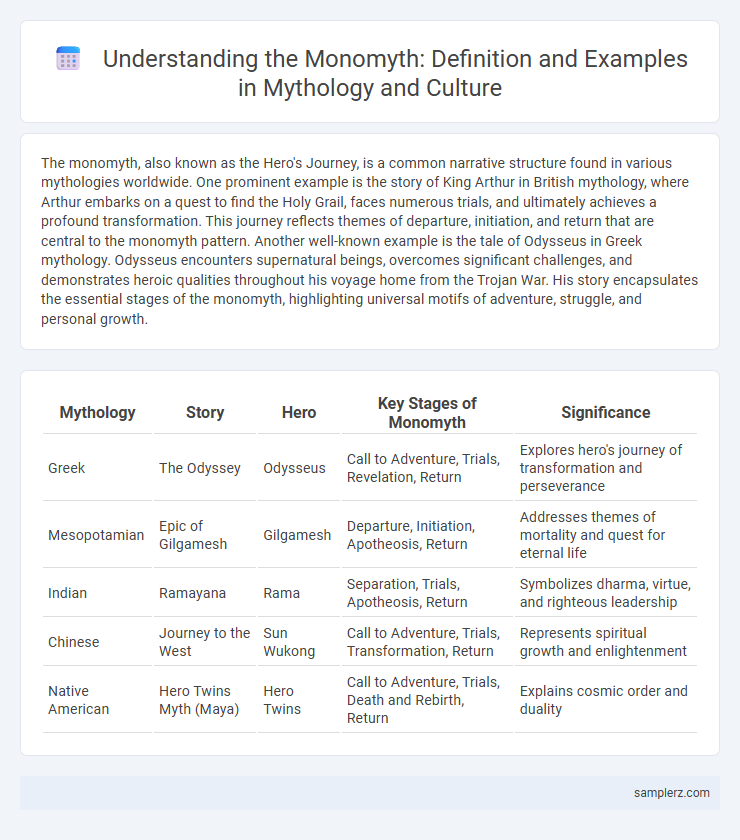The monomyth, also known as the Hero's Journey, is a common narrative structure found in various mythologies worldwide. One prominent example is the story of King Arthur in British mythology, where Arthur embarks on a quest to find the Holy Grail, faces numerous trials, and ultimately achieves a profound transformation. This journey reflects themes of departure, initiation, and return that are central to the monomyth pattern. Another well-known example is the tale of Odysseus in Greek mythology. Odysseus encounters supernatural beings, overcomes significant challenges, and demonstrates heroic qualities throughout his voyage home from the Trojan War. His story encapsulates the essential stages of the monomyth, highlighting universal motifs of adventure, struggle, and personal growth.
Table of Comparison
| Mythology | Story | Hero | Key Stages of Monomyth | Significance |
|---|---|---|---|---|
| Greek | The Odyssey | Odysseus | Call to Adventure, Trials, Revelation, Return | Explores hero's journey of transformation and perseverance |
| Mesopotamian | Epic of Gilgamesh | Gilgamesh | Departure, Initiation, Apotheosis, Return | Addresses themes of mortality and quest for eternal life |
| Indian | Ramayana | Rama | Separation, Trials, Apotheosis, Return | Symbolizes dharma, virtue, and righteous leadership |
| Chinese | Journey to the West | Sun Wukong | Call to Adventure, Trials, Transformation, Return | Represents spiritual growth and enlightenment |
| Native American | Hero Twins Myth (Maya) | Hero Twins | Call to Adventure, Trials, Death and Rebirth, Return | Explains cosmic order and duality |
Defining the Monomyth: Understanding the Hero’s Journey
The monomyth, or Hero's Journey, is a universal narrative pattern identified by Joseph Campbell that outlines a hero's adventure through stages such as departure, initiation, and return. This framework appears across diverse cultures and mythologies, exemplified in legends like Gilgamesh's epic quest, King Arthur's rise, and Odysseus's odyssey in Homeric tales. Understanding the Hero's Journey reveals common psychological and cultural themes of transformation, challenge, and self-discovery that resonate through global storytelling traditions.
Classic Monomyth Examples from Greek Mythology
Greek mythology provides classic monomyth examples such as the hero Odysseus, whose journey in the "Odyssey" encompasses departure, trials, and return, embodying Joseph Campbell's hero's journey framework. Perseus' quest to slay Medusa highlights archetypal stages of supernatural aid, ordeal, and transformation. These mythic narratives illustrate the universal structure of the monomyth, emphasizing themes of heroism and self-discovery.
The Monomyth in Norse Legends
The Monomyth in Norse legends is exemplified by the hero Odin, whose journey follows the classic stages of departure, initiation, and return. Odin's quest for wisdom, including sacrificing his eye at Mimir's well and undergoing trials on Yggdrasil, reflects the archetypal hero's transformation and attainment of secret knowledge. This narrative framework highlights the universal structure of mythic storytelling within Norse culture, emphasizing themes of sacrifice, enlightenment, and cosmic order.
Arthurian Legends: The Monomyth in Celtic Myths
Arthurian Legends exemplify the monomyth through the hero's journey of King Arthur, who receives the call to adventure by pulling Excalibur from the stone, symbolizing divine kingship in Celtic myths. His quest to unite Britain and seek the Holy Grail maps the stages of departure, initiation, and return, reflecting Joseph Campbell's monomyth structure. This narrative integrates archetypal themes of transformation, trials, and ultimate reconciliation, anchoring it firmly within the broader framework of mythic storytelling in Celtic culture.
Monomyth Structure in Ancient Egyptian Stories
Ancient Egyptian mythology exemplifies the monomyth structure through tales such as the story of Osiris, where the hero undergoes death, transformation, and resurrection, symbolizing rebirth and divine kingship. This narrative reflects the stages of departure, initiation, and return as outlined by Joseph Campbell's monomyth framework. The cyclical pattern of Osiris's journey reinforces cultural themes of life, death, and renewal central to Egyptian spiritual beliefs.
Hindu Mythology: Hero’s Journey Reimagined
In Hindu mythology, the Ramayana exemplifies the monomyth structure through Rama's exile, trials, and ultimate victory over evil. This epic journey of separation, initiation, and return echoes Joseph Campbell's Hero's Journey framework, highlighting universal themes of duty, sacrifice, and dharma. The narrative's rich symbolism and archetypes reveal a distinctly Indian cultural interpretation of the classic hero's quest.
Native American Myths: Universal Patterns of the Monomyth
Native American myths vividly illustrate the monomyth through heroic journeys like the emergence of the Raven as a creator and transformer, embodying the universal pattern of departure, initiation, and return. These stories reveal a profound connection to nature and spiritual growth, reflecting the hero's transformation and the restoration of balance. Such narratives emphasize the monomyth's role in preserving cultural identity and transmitting moral lessons across generations.
The Monomyth in African Folklore and Mythology
African folklore and mythology often embody the Monomyth structure through heroes like Anansi the Spider, whose journey involves trials, transformation, and the acquisition of wisdom. These narrative patterns reflect universal themes of initiation, adventure, and return, resonating with Joseph Campbell's concept of the hero's journey. The Monomyth framework in African tales highlights cultural values such as community, resilience, and the interplay between the human and supernatural realms.
East Asian Mythologies: Tracing the Hero’s Journey
In East Asian mythologies, the monomyth or Hero's Journey is exemplified through figures such as the Chinese archer Hou Yi, who embarks on a quest to save the world by shooting down nine suns, symbolizing the journey of sacrifice and transformation. Similarly, the Japanese tale of Momotaro narrates a hero's departure from humble origins, encounters with supernatural allies, and eventual victory over demons, embodying the universal stages of the monomyth. These narratives emphasize themes of perseverance, divine intervention, and restoration of order, reflecting the cultural values embedded within East Asian storytelling traditions.
Cultural Significance of the Monomyth Across Civilizations
The monomyth, or hero's journey, appears across diverse cultures, exemplifying universal themes of transformation and renewal. Mythologies from Greek epics like the Odyssey to Native American legends share this narrative structure, highlighting its role in cultural identity and moral education. This recurring pattern underscores the shared human experience and the transmission of collective values through storytelling.

example of monomyth in mythology Infographic
 samplerz.com
samplerz.com